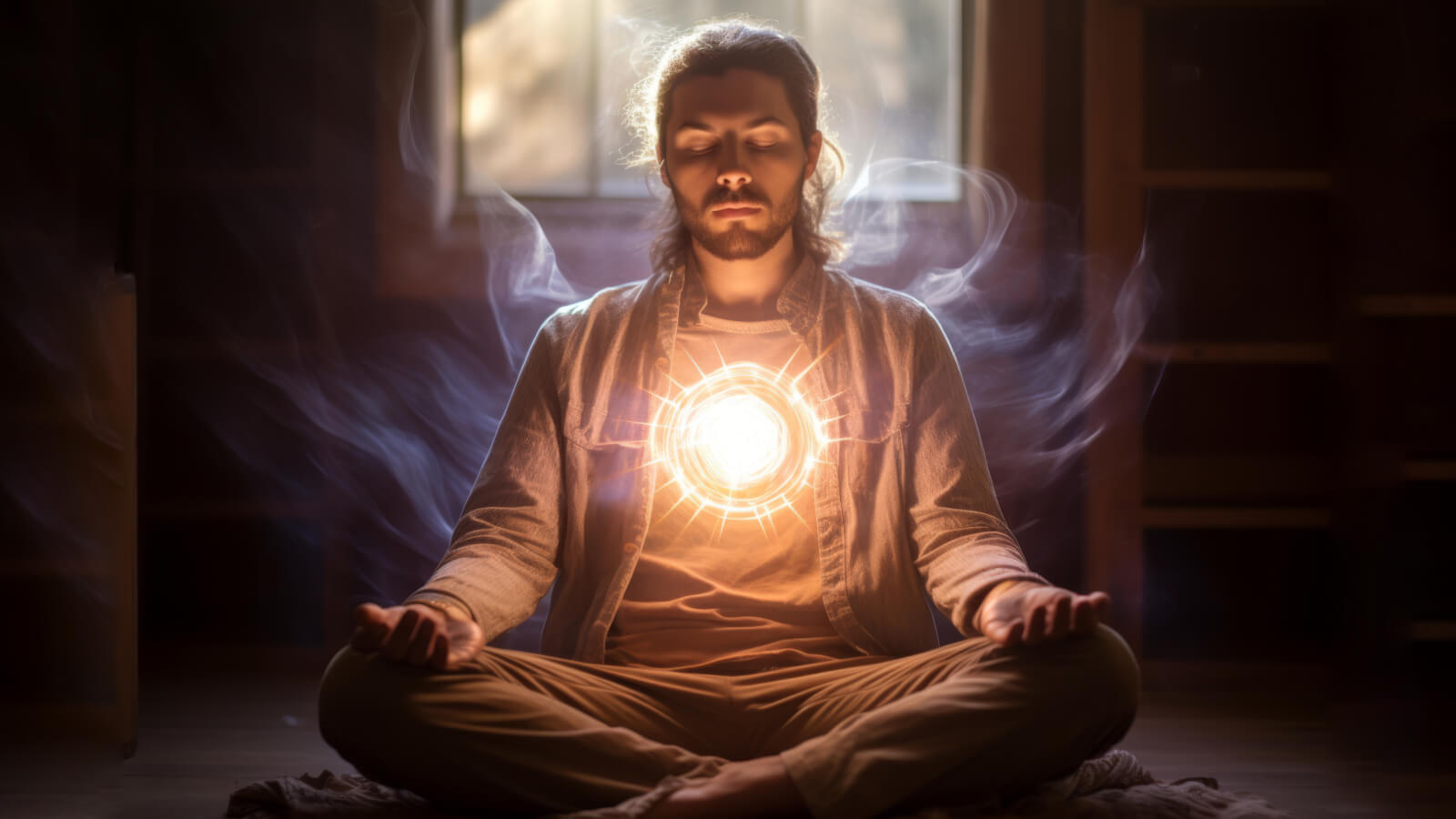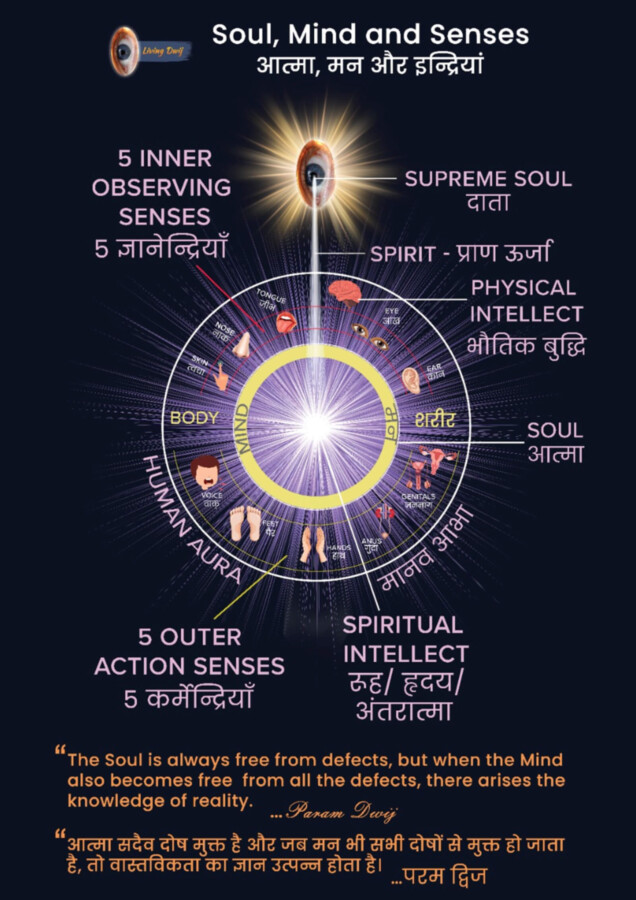The Supreme Alignment: Soul, Mind, and Senses
(Based on the live discourse of Param Dwij)
(परम द्विज के प्रवचन पर आधारित)

Namaste, dear seeker.
Pause for a moment.
Close your eyes gently, allowing the world around you to fade away. Take a deep, long breath in… and slowly breathe out, letting go of any tension or distractions. Now, turn your attention inward and ask yourself—who is truly breathing? Is it just your lungs that are expanding and contracting? Or is your body functioning steadily in a continuous rhythm, like a song? Or the name you were given at birth that formed your identity clinging tightly to you? Or the many roles you fulfil in the tapestry of life?
But delve deeper, dear one. Peek into the essence of your being—your true self—is not defined by these surface layers. It is you, the observer of your thoughts and feelings, the witness to your experiences, the timeless soul that exists beyond names, forms, and societal functions.

This literary work is not intended as a lesson to be learned but rather as a reflective mirror to help you see the depth of your own existence. It is a space crafted not for the busy mind but for the quiet inner ear— that intuitive part of you that listens in stillness without the cacophony of the outer world interfering. Through these words, I invite you to remember who you are at your core, to reconnect with the silence that holds all wisdom, and to embody the peaceful presence that resides within you.
I. The Great Disconnect
The soul—your soul—remains eternally pure. It is a glowing essence that exists far beyond the mere boundaries of birth and death, which remain untouched and unbothered by the volatile emotions of joy or sorrow. It is a foundational aspect of your being, your existence, unrestrained by the different conditions of the physical world and embodying true freedom.
So why do we have this ache that never goes away? Why do we constantly pursue ephemeral joys, long for love, and aim for achievement only to discover that we are struggling with a deeper emptiness?
Our detachment from our actual center holds the solution. We frequently give up control of our inner chariot in our day-to-day lives, letting our senses, our ravenous appetites, and the various identities we take on in society pull it. Our sense of emptiness is heightened or increased by the dissonance created by this chaotic ride that pulls us away from the core of who we are. We lose sight of the constant inner truth that exists within us as we become entangled in external validations. We can only live authentically and fulfilledly if we remember who we are at our core.
We are not defined by our possessions, our actions, or even our emotions. Rather, we are the conscious observer—the one who sees beyond the surface. Yet, we find ourselves ensnared by the physical form, tethered to the relentless chatter of the mind, and lured by the fleeting pleasures of the senses.
The regal essence within us has forgotten its rightful place on the throne of our awareness. Layers of neglect have shrouded the inner light, much like a lamp gathering dust in a forgotten corner of a room. A mess of turbulent clouds has obscured what once was a vast, open and inviting sky, a world full of possibility and clarity, and has reduced the brightness of our true honest nature. In spite of all of this confusion and mayhem, a glimmer of light persists. It acts as a continual reminder that the essence of who we are is pure and ever-present despite all the distractions and illusions. It is the eternal spark of who we really are, just awaiting acceptance and acknowledgment.
II. The Architecture of Inner Being
Let us turn our focus inward, but not through the lens of logic and reason, do it with the quiet awareness of silence. In this profound silence, you can start to see cleraly and unfold the intricate workings of your inner universe, which is a complex and beautiful tapestry of thoughts, emotions, and energies. By taking out the time to explore this divine formation inside yourself, you can cultivate and establish a deeper understanding about yourselves, what are the things that motivates you, and your connections to the world around you. You can uncover the profound wisdom that is at the foundation of your existence by following this contemplative and transformative journey, which will reveal hidden truths about yourself.
1. Soul (Atma)
No matter how time and circumstances in your life change, there are some timeless quality that makes you unique will stay the same. A deep and profound awareness—a calmness that rises above the chaos of life—lies at the center of your consciousness. This essence exists in a world outside of the physical; it is neither born nor dies. It reminds you that your true identity lies in the boundless space of your true self and is not limited to transient experiences. It is always free and embodies an unwavering spirit of liberation.
2. Spirit (Pran Urja)
The vital force that keeps you alive is the energy that gives your body fuel for life. It permeates every breath you take, providing your cells with the oxygen they require to survive. By establishing a harmonious connection that unifies your physical experiences with your emotional and mental ones, this energy acts as a link between your soul and the complex processes of your mind and body. It encourages physical vitality as well as a deep sense of awareness and purpose by enabling you to interact with the world around you. Gaining an understanding of this energy can improve your general wellbeing and strengthen your bond with yourself.
3. Mind (Mann)
A rich tapestry of feelings, ideas, fantasies, and fears entwine in the vast garden of our inner world. This garden actively responds to our experiences and desires rather than merely being a passive landscape. It avoids pain and discomfort while clinging to happy and successful moments. Our emotions can grow in this garden, leading us to comprehension and connection, but they can also trap us, turning into a strong but dangerous master. In the end, this complex interaction emphasizes how critical it is to take care of our inner selves, practice balance, and take charge of the garden rather than allowing it to control us.
4. Physical Intellect (Bhautic Buddhi)
In our daily lives, the ability to reason and analyze is a powerful tool for strategic planning and decision-making. It is excellent at navigating the real world, assisting us in breaking down issues, finding answers, and formulating a plan of action supported by data. But when it comes to the invisible and unexplored facets of life—the sacred elements that defy quantification and logical reasoning—this analytical method fails. These domains include spirituality, intuition, and the deep mysteries that influence our human existence. We must be open to the deeper, frequently indefinable truths that are outside the realm of conventional reasoning, even as we use logical frameworks to help us navigate the material aspects of our lives.
5. Spiritual Intellect (Ruh / Hriday / Antaratma)
Our journey is subtly guided by the silent compass of truth that is inside of us. This inner compass becomes our most trustworthy guide when we turn it on, blazing a bright light on the way ahead. It just knows the way, based on a profound comprehension of who we really are, and doesn’t argue or debate.
Every aspect of our being contributes to this journey—thoughts, emotions, desires—but only one element reigns supreme: the Soul. The Soul acts as the ruler, a wise and authentic leader that governs our choices and actions. Meanwhile, all other facets must learn to serve this higher power, supporting its wisdom rather than attempting to dominate it. In this harmonious balance, we find the path to genuine fulfilment and purpose.
III. The Ten Senses: The Instruments of Experience
Your experience of the world is made possible through ten gateways:
Inner Observing Senses (Gyanendriyas):
Eyes — The eyes are the portal to sight. The main way we experience the visual world is through our eyes, which have a complex structure and the capacity to perceive a rich tapestry of colors and movements. They not only assist us in navigating our environment, but they also tell stories and express emotions without the use of words.
Ears — the gateway of sound: From the delicate rustle of leaves to the intricate melodies of music, the ears allow us to perceive a wide variety of sounds. Sound is a vital component of our social interactions and emotional experiences because it enables us to connect with others, communicate, and express our feelings.
Nose — The gateway of smell: Our memories and emotions are intimately connected to our sense of smell, which is made possible by our nose. It enhances our perception of the world by enabling us to enjoy the rich flavors of food, identify well-known aromas, and even spot danger like smoke or spoiled materials.
Tongue — the gateway of taste: Our tongue is essential for identifying and enjoying various flavours, which play a significant role in our eating habits and culinary experiences. It helps us differentiate between sweet, salty, sour, bitter, and umami, allowing for a deeper appreciation of the complexities of food.
Skin — the touch-gateway: The largest organ in the body, the skin, has a variety of receptors that enable us to feel texture, temperature, and pressure. By providing comfort, protection, and a way to explore our surroundings, this sense of touch enables us to connect with others through physical contact.
Together, these senses act as windows to our minds, shaping our perceptions, influencing our thoughts and feelings, and creating a rich, multifaceted experience of the world around us.
Outer Action Senses (Karmendriyas):
Hands are more than just physical appendages; they are the instruments through which we grasp the world around us, hold onto what is precious, give love and support, and take in the experiences life offers.
Feet carries us through our journeys, allowing us to move forward, walk the paths of our lives, and run toward our dreams and aspirations. Each step we take is a testament to our desire for progress and exploration.
Our speech has the power to shape our reality. It serves as a means to communicate our thoughts and feelings, to bless those we care for, or to inflict hurt when words are wielded carelessly. The voice we use can build bridges or create chasms.
The miracle of life is made possible by the genitals, the entryway to creation. They represent the natural human desire for pleasure as well as the holy act of bringing new creatures into the world.
The anus plays a role, too, symbolizing our ability to eliminate waste, to release what no longer serves us, and to embrace the cycle of renewal.
These are the fundamental instruments for negotiating interactions in the real world. However, it is crucial to realize that these instruments are neutral and meaningless by nature until they are influenced by our goals and convictions. Our awareness of the soul influences the mind, which determines whether these actions are pure or impure. A mind that sees and interacts with the world in a more pure light is thus fostered by cultivating a connection with the soul. Keep in mind, my love: our actions are fundamentally internal.
IV. The Trap of Inversion
What occurs when our senses begin to take control? When the intellect, rather than serving our higher purpose, rises to become the master of our existence? When the mind, in its pursuit of understanding, neglects the deeper essence of the soul?
We frequently find ourselves becoming reactive, agitated, and disorganized in our thoughts and behaviors in such a situation. We frequently feel more empty and unsatisfied than before as a result of our daily lives becoming unrelenting quests for love, approval, and transient pleasures. The natural order of our being is inverted in this phenomenon, which can be referred to as inversion.
The Soul must lead the Intellect and make sure that our higher wisdom influences our decisions and thoughts in order to bring about harmony again. The mind should be governed by the intellect, which should give guidance based on reason and logic. In order to help us filter and interpret the world around us in a balanced way, the Mind must lastly instruct the Senses.
When this hierarchical structure is disrupted and the sequence is reversed, we invite darkness and confusion into our lives. But it’s crucial to keep in mind that this reversal is not final. Realigning our priorities and reestablishing a connection with our authentic selves is the first step towards bringing about change. By guiding us away from the chaos and toward a state of peace and fulfillment, every tiny effort helps to restore equilibrium.
V. The Path of Reversal: From Senses to Soul
Here lies the sacred formula:
“The Soul is always free from defects, but when the Mind also becomes free from all the defects, there arises the knowledge of reality.” — Param Dwij
Let us now walk the path—not just in theory, but in practice.
Step 1: Observe, Don’t Absorb
See. Hear. Touch. Taste. Smell. But do not become these experiences.
Be the screen—not the movie.
Step 2: Sit with Yourself Daily
Set aside time—not for chanting or rituals—but for pure being. Just sit. Let breath be. Let thoughts come and go. Do not chase them. Do not push them.
Eventually, the noise will settle. The lake of the mind will still. And in that still water, you will see your true reflection.
Step 3: Celibacy of the Senses
Instead of being seen as a kind of punishment, restraint should be seen as an empowerment tool. It involves taking charge of one’s impulses and desires and directing them toward a more meaningful life. Aim for a comprehensive strategy that goes beyond simple physical abstinence in order to develop true celibacy. This entails acting and thinking celibately in addition to being celibate physically:
Eyes: Practice not objectifying others; instead, see them as whole individuals with their own stories and experiences.
Ears: Avoid engaging in gossip, choosing instead to listen to uplifting and constructive conversations that enrich your understanding of the world.
Tongue: Refrain from gluttony; savour your nourishment mindfully, appreciating the journey of every meal without excess.
Skin: Resist indulgence in fleeting pleasures; instead, seek meaningful connections and experiences that promote deeper intimacy and fulfilment.
Mind: Steer clear of fantasy and distraction, focusing on realities that encourage growth and genuine appreciation of your surroundings.
You train your senses and gain control over them through this focused practice. This empowerment improves your interactions with the outside world and results in a deeper understanding of who you are.
Step 4: Surrender to Daata
You are not alone in this journey. There is a force, a presence, a source—Daata.
You need not walk the path. You only need to surrender to it. In every moment of temptation, whisper: Daata, carry me. In every moment of confusion, pray: Daata, guide me. And you will be lifted. Not by effort. But by grace.
VI. A Dwij’s Way of Living
A Dwij is not just one who is born twice. A Dwij is one who has awakened. The first birth is from the womb. The second birth is from the womb of silence.
To be a Dwij is to walk in the world untouched by it. To eat, talk, move—but from awareness, not compulsion.
A Dwij prays:
“Let me not forget who I am today.”
A Dwij lives:
“Let every step return me to the centre.”
A Dwij sleeps:
“What did I surrender today? And what must I still release?”
VII. Daily Practice: The Four Sacred Pillars
- Silence (30-60 minutes daily):
- No goal. Just presence.
- Let the storm within settle naturally.
- Sacred Consumption:
- What you watch, hear, eat, speak—all of it must be sacred.
- Before every act, ask: Is this aligning me with my soul? Or taking me away?
- Daily Reflection:
- Journal the highs and lows of awareness.
- Where did you fall into the habit?
- Where did you rise into presence?
- Unbroken Remembrance of Daata:
- Let every breath carry His name.
- Let every action reflect His presence.
This is not devotion. This is integration.
VIII. The Inner Revolution
The world will continue its dance. There will still be gains and losses. There will still be noise.
But you will stand as a mountain. Not because the storms stopped—but because you discovered the cave within.
You will see the game but not be played by it. You will hear the chaos but respond with calm. You will act—but from stillness.
That is freedom. That is awakening. That is living as the soul.
IX. In Closing
You are not a seeker trying to become something. You are the Self, remembering yourself.
You are the sun behind the clouds. The song behind the noise. The silence behind the scream.
Every day, remove one veil. And you shall shine—not one day, but now.
“Aatma sadaiv doshmukt hai, aur jab mann bhi sabhi doshon se mukt ho jaata hai, to vaastavikta ka gyaan utpann hota hai.” — Param Dwij
The time is not tomorrow. The time is now.
The path is not difficult. It is just forgotten.
So remember, dear one.
With love, light, and stillness,
Param Dwij



